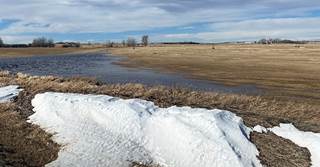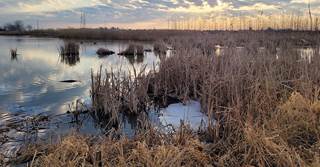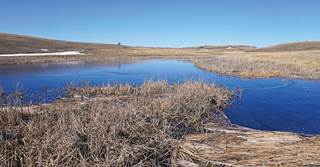An overview of wetland conditions across key waterfowl breeding areas

In British Columbia, snow accumulations were average this year along the south coast and in the interior. Little snow is left on the landscape in the interior, but the ground remains frozen and typical runoff is expected. Up north, winter snowfall was above average and a good frost seal is in place, which should produce favorable wetland conditions this spring. As of mid-March, large numbers of migrating waterfowl had yet to arrive in the interior, while wintering snow geese remained along the coast.
Winter temperatures across this vast region were average in January and slightly below average in February. In the Yukon, runoff from a record snowpack could lead to flooding, depending on how fast temperatures rise this spring. In northern Alberta and Saskatchewan, significant runoff is likely, but dry soils may absorb some of the moisture from melting snow.

In southern Alberta, warm temperatures and below-average precipitation have limited the availability of wetland habitat on the landscape for returning waterfowl.
Photo © DU Canada
Southern Alberta has been warmer and drier than average, and most of the snowpack melted early, limiting wetland habitat for returning waterfowl. Saskatchewan and Manitoba were cooler, and winter precipitation was near normal in these provinces. However, a dry fall and variable frost seal will likely limit wetland recharge without significant additional precipitation. Canada geese returned to the prairies in early March, and other waterfowl species are now beginning to arrive in the south.
Winter temperatures were cooler than average in Ontario and Quebec, but southern and eastern portions of these provinces warmed up quickly in March. Precipitation amounts were average except in the north and in southwestern Ontario, which were slightly drier than average. Permanent wetland basins are full, and early nesting mallards and American black ducks are making use of these habitats as surface waters thaw.

In Ontario and Quebec, permanent wetlands are full and will provide reliable habitat for breeding pairs and broods after the spring thaw.
Photo © DU Canada
Atlantic Canada received above-average precipitation this winter—nearly double the typical amount in some areas—but midwinter warm spells and rain reduced the snowpack in the south. Wetlands started to thaw, and early migrants began arriving in mid-March. Lots of water on the landscape this spring is expected to provide great habitat for breeding waterfowl.
Much-needed winter and early spring precipitation relieved drought conditions across the eastern Dakotas. If spring precipitation continues, average wetland conditions are expected in these areas. In northwest North Dakota and northeast Montana, however, winter snowfall was below average and severe drought persists. Without considerable spring precipitation to replenish dry wetland basins, below-average wetland conditions are expected in these areas. Although bitter cold temperatures in early March delayed the spring migration, wetlands began to thaw by the end of the month, and nest initiation for many waterfowl species is expected to begin on time.

The outlook for waterfowl production has improved in the eastern Dakotas, where much-needed precipitation and runoff have filled some wetland basins.
Photo © Ben Romans, DU
February and March provided much-needed precipitation across many areas of the Great Lakes region and the Northeast. However, abnormally dry and moderate drought conditions persist in parts of Wisconsin and Michigan, as well as in small areas of Pennsylvania, New Jersey, and New England. Additional precipitation will be necessary to improve spring habitat conditions for breeding waterfowl in these areas.
The drought continues to worsen in the Central Valley of California, where much of the rice crop will go unplanted this year. Wetland water supplies for the coming fall are predicted to be 50 percent or less of what is needed, and the amount of early season habitat is likely to be greatly reduced. Poor snowpacks failed to rescue either the Klamath Basin refuges or the Great Salt Lake from the current drought, further compounding problems across the Pacific Flyway. On a brighter note, habitat conditions in Alaska look promising, which is good news for western hunters who receive many of their birds from the state.
Ducks Unlimited uses cookies to enhance your browsing experience, optimize site functionality, analyze traffic, and deliver personalized advertising through third parties. By continuing to use this site, you agree to our use of cookies. View Privacy Policy